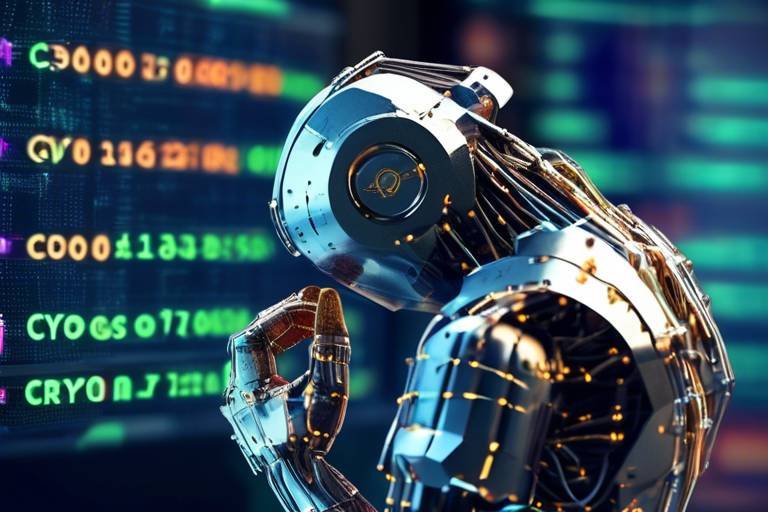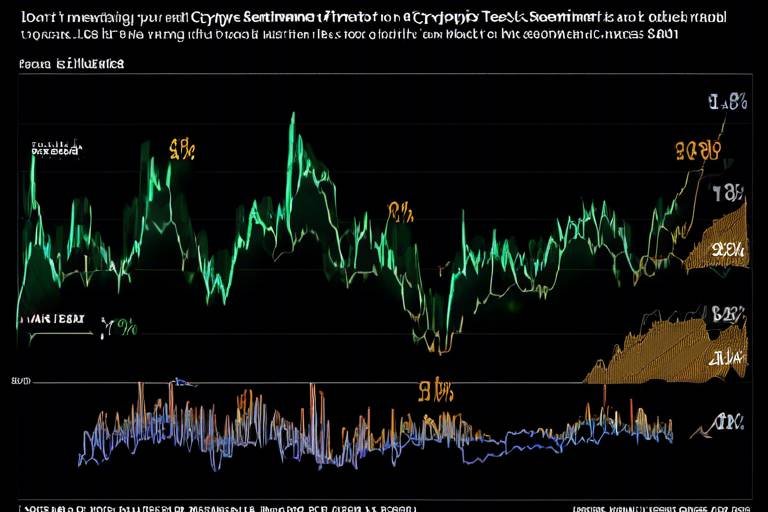The Future of Automated Trading in Crypto Markets
The world of cryptocurrency is evolving at a breakneck pace, and with it, the methods traders use to navigate these turbulent waters. Automated trading has emerged as a game-changer, revolutionizing how traders approach the market. But what does the future hold for this innovative trading strategy? As we look ahead, it’s clear that the landscape will be shaped by advancements in technology, particularly in artificial intelligence (AI) and machine learning, which promise to enhance the capabilities of automated trading systems. Imagine a world where trades are executed with pinpoint accuracy, where algorithms can predict market movements with uncanny precision, and where traders have the tools to make informed decisions without the emotional baggage that often clouds judgment.
In the coming years, we can expect to see a significant shift in how traders interact with the market. As automated trading systems become more sophisticated, they will be able to analyze vast amounts of data in real time, providing insights that were previously unattainable. This will not only increase the efficiency of trading strategies but also democratize access to advanced trading tools, allowing even novice traders to compete on a level playing field with seasoned professionals.
Moreover, the integration of AI into automated trading systems will lead to the development of adaptive algorithms that can learn from market behavior and adjust strategies accordingly. This means that traders will no longer need to constantly monitor their systems; instead, they can rely on intelligent algorithms to make decisions based on pre-set criteria and evolving market conditions. Picture a trading bot that not only executes trades but also learns from its successes and failures, continuously refining its approach to maximize profits while minimizing risks.
However, as we embrace these advancements, we must also consider the challenges that lie ahead. The crypto market is infamous for its volatility, and while automated trading can help mitigate some risks, it is not immune to sudden market shifts. Traders will need to remain vigilant, ensuring that their systems are equipped to handle unexpected price fluctuations. Additionally, regulatory scrutiny is likely to increase as governments seek to establish frameworks for the burgeoning crypto market, which could impact how automated trading systems operate.
Ultimately, the future of automated trading in crypto markets is bright, but it requires a balanced approach. Traders must be prepared to adapt to changing technologies and market conditions while leveraging the advantages that automation offers. As we stand on the brink of this new era, one thing is certain: the fusion of technology and trading will reshape the industry in ways we can only begin to imagine.
- What is automated trading? Automated trading refers to the use of algorithms and software to execute trades in financial markets without human intervention.
- How does automated trading benefit traders? It offers increased speed, reduced emotional bias, and improved accuracy, allowing traders to capitalize on market opportunities more effectively.
- What challenges does automated trading face? Key challenges include technical failures, market volatility, and regulatory concerns that can impact trading strategies.
- What is the role of AI in automated trading? AI enhances automated trading by enabling systems to learn from data, adapt to market changes, and make informed trading decisions.

The Rise of Automated Trading
Automated trading has surged in popularity within the cryptocurrency markets, and it's not just a passing trend. The roots of this phenomenon can be traced back to the early days of algorithmic trading in traditional finance, but with the explosive growth of cryptocurrencies, the stakes have never been higher. So, what exactly has propelled automated trading into the spotlight? It’s a combination of technological advancements, the inherent volatility of the crypto market, and a growing need for efficiency among traders.
To understand this rise, we need to look at a few key factors. First, the availability of sophisticated trading algorithms has made it easier for traders to implement complex strategies without constant supervision. These algorithms can analyze vast amounts of data in real-time, making split-second decisions that human traders simply cannot match. Imagine trying to catch a bullet train; you’d need to be quick, and that’s exactly what automated trading systems do—they catch those fleeting opportunities in the market that can lead to significant profits.
Another significant factor is the decentralization and 24/7 nature of cryptocurrency markets. Unlike traditional stock exchanges, which have set hours, crypto markets never close. This constant activity creates a perfect environment for automated trading systems to thrive. Traders can set their algorithms to monitor market movements continuously, ensuring they don’t miss out on potential trades, even while they sleep. In essence, automated trading is like having a tireless assistant who works around the clock to find the best deals.
Moreover, the community surrounding cryptocurrencies has embraced innovation and technology. Many traders are tech-savvy and eager to adopt new tools that can give them a competitive edge. This culture of innovation has led to the rapid development of various automated trading platforms, each offering unique features and capabilities. For instance, some platforms allow users to backtest their strategies against historical data, providing invaluable insights into what might work in the future.
In summary, the rise of automated trading in the cryptocurrency arena is a multifaceted phenomenon fueled by technology, market dynamics, and a culture of innovation. As we look ahead, it’s clear that the integration of automation into trading strategies is not just a fleeting trend; it’s likely to become a fundamental aspect of how trading is conducted in the digital age. The question remains—how will traders adapt to this changing landscape, and what new opportunities will arise from this technological evolution?

Benefits of Automated Trading
Automated trading has revolutionized the way traders engage with the cryptocurrency markets. With the rapid pace of technological advancement, the benefits of using automated trading systems have become increasingly clear. First and foremost, one of the most significant advantages is the increased speed at which trades can be executed. In the world of crypto, where prices can change in the blink of an eye, having the ability to act quickly can make all the difference between a profitable trade and a missed opportunity. Algorithms can analyze market data and execute trades in milliseconds, allowing traders to capitalize on fleeting opportunities that would be impossible to catch manually.
Another critical benefit is the reduction of emotional trading. Trading can often be a rollercoaster of emotions, especially in the highly volatile crypto markets. Traders may find themselves making impulsive decisions based on fear or greed, leading to costly mistakes. Automated trading systems, however, operate based on predefined rules and strategies, allowing traders to maintain discipline and adhere to their plans without emotional interference. This adherence to strategy can significantly improve overall trading performance.
When we talk about efficiency, it is essential to recognize that automated trading systems work tirelessly, analyzing vast amounts of data and executing trades around the clock. This capability is particularly beneficial in the crypto market, which operates 24/7. Traders no longer need to be glued to their screens at all hours; instead, they can set their systems to monitor the market continuously. This not only saves time but also allows traders to focus on other important aspects of their trading strategies or even personal endeavors.
The nature of cryptocurrency markets means that they are always open, unlike traditional stock markets that have set trading hours. Automated trading systems can exploit this continuous access to maximize profits. Traders can program their systems to execute trades based on specific market conditions, ensuring that they do not miss out on profitable opportunities, even while they sleep. For instance, if a favorable trading signal arises at 3 AM, an automated system will act on it without any delay, something that would be impossible for a human trader.
Emotional trading can be likened to driving a car while blindfolded; it’s risky and often leads to disastrous outcomes. Automated trading alleviates this issue by adhering strictly to data-driven strategies. By eliminating emotional biases, traders can make more informed decisions based on analytics rather than gut feelings. This leads to a more consistent trading approach, as decisions are based on logic and data rather than fluctuating emotions.
Furthermore, the accuracy of automated trading systems cannot be overstated. These systems leverage sophisticated algorithms and data analysis to execute trades with remarkable precision. Unlike human traders, who may overlook critical data points or misinterpret market signals, automated systems can process vast amounts of information quickly and accurately. This enhanced accuracy not only improves the chances of successful trades but also contributes to a trader's overall strategy by enabling backtesting and optimization of trading parameters.
To summarize, the benefits of automated trading in cryptocurrency markets are vast and varied. From increased speed and efficiency to reduced emotional bias and improved accuracy, automated trading systems offer traders a significant edge in an ever-evolving market landscape. As technology continues to advance, it will be fascinating to see how these benefits evolve and what new opportunities will arise for traders willing to embrace automation.
- What is automated trading? Automated trading refers to the use of computer algorithms to execute trades based on predetermined criteria without human intervention.
- How does automated trading reduce emotional bias? By following strict algorithms and trading rules, automated systems eliminate the influence of emotions, allowing for more disciplined trading.
- Can automated trading systems guarantee profits? While automated trading can enhance efficiency and accuracy, it does not guarantee profits. Market conditions can change rapidly, and risks remain.
- Are there risks involved with automated trading? Yes, there are risks such as technical failures, market volatility, and regulatory issues that traders should consider.

Efficiency and Speed
In the fast-paced world of cryptocurrency trading, efficiency and speed are not just advantages; they are necessities. Imagine trying to catch a lightning bolt with your bare hands—this is what trading without automation feels like. The crypto market is notorious for its volatility, where prices can swing dramatically in mere seconds. Automated trading systems are designed to execute orders at lightning speed, allowing traders to capitalize on fleeting opportunities that would otherwise be missed in the blink of an eye.
These systems utilize sophisticated algorithms that analyze market trends and execute trades based on predefined criteria. This means that while a human trader might take a moment to think or hesitate, an automated system is already in the process of making the trade. In fact, studies have shown that automated trading can execute trades up to 100 times faster than a human trader. This speed not only improves the chances of securing a favorable price but also reduces the risk of slippage—a common issue where the execution price differs from the expected price due to market fluctuations.
Moreover, the efficiency of automated trading systems allows traders to manage multiple assets simultaneously. Instead of being tied to a single trading screen, traders can diversify their portfolios across various cryptocurrencies without the need for constant monitoring. This is particularly beneficial in a market that never sleeps, as crypto trading operates 24/7. By leveraging automation, traders can ensure that they are always in the game, even while they sleep.
To illustrate the importance of speed in automated trading, consider the following table that compares traditional trading methods with automated trading systems:
| Feature | Traditional Trading | Automated Trading |
|---|---|---|
| Execution Speed | Seconds to Minutes | Milliseconds |
| Order Management | Manual | Automated |
| Market Monitoring | Constant Attention Required | 24/7 Monitoring |
| Emotional Influence | High | None |
As you can see, the advantages of automated trading are clear. The ability to execute trades quickly and efficiently not only enhances a trader's performance but also allows for better risk management. By eliminating the emotional component of trading, automated systems help traders stick to their strategies and make decisions based on data rather than impulse. In a market as unpredictable as cryptocurrency, this discipline can be the difference between profit and loss.
In summary, the efficiency and speed provided by automated trading systems make them a game-changer in the crypto markets. With the right technology, traders can navigate this volatile landscape with confidence, ensuring they are always one step ahead of the competition.
- What is automated trading? Automated trading involves using computer algorithms to execute trades based on predetermined criteria, allowing for faster and more efficient trading.
- How does automated trading improve efficiency? By executing trades at lightning speed and managing multiple assets simultaneously, automated trading systems enhance a trader's ability to capitalize on market opportunities.
- Are there risks associated with automated trading? Yes, while automated trading offers numerous benefits, it also comes with risks such as technical failures and market volatility that can impact trading performance.
- Can automated trading eliminate emotional trading? Absolutely! Automated systems are designed to follow strict rules, thereby reducing the influence of emotions on trading decisions.

24/7 Market Access
The world of cryptocurrency trading is a thrilling rollercoaster ride that never stops. Unlike traditional stock markets that have set hours, the crypto market operates 24 hours a day, 7 days a week. This constant availability means that traders can seize opportunities at any hour, whether it’s the crack of dawn or the dead of night. Imagine being able to buy and sell assets whenever you want, without the constraints of time zones or market hours. This is where automated trading systems shine, offering a level of flexibility that is simply unmatched.
Automated trading systems are designed to operate continuously, allowing traders to set their strategies and let the algorithms do the heavy lifting. This means that while you’re sleeping, your automated trading bot could be executing trades based on pre-defined strategies, capitalizing on price movements that you might miss. It’s like having a tireless assistant who never takes a break! The ability to trade around the clock can significantly increase the potential for profit, especially in a market as dynamic as cryptocurrency.
Moreover, the 24/7 access to the market enables traders to react swiftly to breaking news or sudden shifts in market sentiment. For instance, if a major announcement impacts a cryptocurrency's price, automated systems can instantly execute trades to either capitalize on the surge or mitigate losses. This responsiveness is crucial in a landscape where prices can swing dramatically in a matter of minutes.
However, it’s important to note that while the access is always there, it doesn’t mean that traders should be glued to their screens at all hours. The beauty of automation is that it allows you to set your parameters and trust the system to act in your best interest. Think of it as a well-oiled machine that works tirelessly, so you don’t have to. This not only saves time but also helps in maintaining a healthy work-life balance, something that’s often overlooked in the fast-paced world of trading.
In conclusion, the provided by automated trading systems is a game-changer for crypto traders. It empowers them to take advantage of global market movements without the need for constant supervision. As technology continues to evolve, this feature will likely become even more sophisticated, offering traders new ways to enhance their strategies and maximize their potential gains.
- What is automated trading? Automated trading refers to the use of algorithms and computer programs to execute trades on behalf of traders, eliminating the need for manual intervention.
- How does 24/7 market access benefit traders? It allows traders to react to market changes at any time, increasing the chances of profit and reducing the risk of missing out on opportunities.
- Can automated trading systems fail? Yes, technical failures can occur, which is why it’s essential for traders to monitor their systems and have contingency plans in place.
- Is automated trading suitable for beginners? While it can be beneficial, beginners should thoroughly understand the market and their strategies before relying solely on automation.

Reduced Emotional Bias
In the fast-paced world of cryptocurrency trading, emotions can run high. Traders often find themselves caught in a whirlwind of fear, greed, and excitement, leading to impulsive decisions that can jeopardize their investments. This is where automated trading systems shine brightly. By utilizing algorithms and pre-set strategies, these systems effectively eliminate emotional bias from the trading equation. Imagine being able to execute trades based solely on data and analysis, rather than the rollercoaster of human emotions. It’s like having a calm and collected trading partner who never panics, no matter how wild the market swings.
One of the most significant advantages of automated trading is its ability to stick to a predetermined plan. When traders rely on their instincts, they may deviate from their original strategy, especially during periods of high volatility. Automated systems, however, are programmed to follow specific criteria without faltering. This adherence to strategy not only enhances discipline but also fosters a sense of consistency in trading practices. For instance, a trader might set a rule to buy when a cryptocurrency drops by 5% and sell when it rises by 10%. An automated system will execute these trades precisely as instructed, without second-guessing or emotional interference.
Moreover, the elimination of emotional bias can lead to better risk management. Traders often struggle with the psychological aspects of loss, which can cause them to hold onto losing positions for too long or to sell winning positions too early out of fear. Automated trading systems can be programmed to incorporate strict risk management protocols, ensuring that trades are closed based on objective criteria rather than emotional responses. This can significantly enhance a trader's ability to manage their portfolio effectively.
In addition to these benefits, automated trading systems also provide valuable insights through data analysis. By continuously monitoring market conditions and performance metrics, traders can gain a clearer understanding of their strategies' effectiveness. This data-driven approach enables traders to make informed adjustments to their systems, further reducing the likelihood of emotional decision-making.
Ultimately, the integration of automated trading in the cryptocurrency market represents a significant shift towards a more rational and disciplined trading environment. As traders increasingly recognize the importance of emotional control, the adoption of these systems is likely to grow. In a landscape where every second counts, being able to rely on technology to manage emotions could be the difference between success and failure.
- What is automated trading? Automated trading involves using computer algorithms to execute trades based on predefined criteria without human intervention.
- How does automated trading reduce emotional bias? By following programmed strategies, automated trading systems eliminate the influence of emotions like fear and greed, leading to more disciplined trading.
- Can automated trading systems adapt to market changes? Yes, many automated trading systems can be programmed to adjust strategies based on market conditions, enhancing their effectiveness.
- Are there risks associated with automated trading? Yes, while automated trading can reduce emotional bias, it also carries risks such as technical failures and market volatility that traders must consider.

Improved Accuracy
In the fast-paced world of cryptocurrency trading, accuracy is not just a luxury; it’s a necessity. Automated trading systems, powered by sophisticated algorithms, are designed to analyze vast amounts of data and make decisions with pinpoint precision. Imagine trying to hit a moving target in a game of darts while blindfolded—now, picture having a high-tech system that removes the blindfold, allowing you to see every detail. This is what automated trading offers to traders in the crypto markets.
One of the key advantages of automated trading systems is their ability to process data at an incredible speed. These systems can evaluate market conditions, historical data, and even news events in real time. By leveraging machine learning and artificial intelligence, they adapt to changing market dynamics and refine their strategies continuously. This adaptability is crucial in an environment where prices can swing wildly within seconds.
Moreover, automated trading reduces the risk of human error. Traders, especially those who are new or inexperienced, can make impulsive decisions based on emotions like fear or greed. In contrast, automated systems operate based on predefined criteria, executing trades with unwavering discipline. For instance, if a trader sets a rule to buy Bitcoin when it dips below a certain price, the automated system will execute that trade exactly as programmed, without second-guessing or hesitation.
To illustrate the difference in accuracy between manual and automated trading, consider the following table that compares typical outcomes:
| Aspect | Manual Trading | Automated Trading |
|---|---|---|
| Speed of Execution | Slower, often delayed | Instantaneous |
| Emotional Influence | High, can lead to mistakes | None, strictly follows rules |
| Data Analysis | Limited, often subjective | Extensive, objective |
| Adaptability | Slow to adjust strategies | Quickly adapts to market changes |
As we can see, automated trading systems excel in key areas that contribute to overall accuracy. They not only execute trades faster but also do so without the emotional biases that can cloud judgment. This leads to more consistent results over time, making them an attractive option for both novice and experienced traders alike.
In conclusion, the improved accuracy provided by automated trading systems is transforming the landscape of cryptocurrency trading. By minimizing human error and leveraging advanced technologies, traders can make more informed decisions, capitalize on market opportunities, and ultimately enhance their trading performance. As we move forward, the role of automation in trading is set to become even more significant, paving the way for a new era of precision in the crypto markets.

Challenges of Automated Trading
While automated trading in cryptocurrency markets brings a plethora of benefits, it is not without its challenges. One of the most significant issues traders face is the risk of technical failures. Imagine setting up a perfectly optimized trading bot only to find that it crashes during a critical market movement. Such malfunctions can lead to substantial financial losses, potentially wiping out gains accumulated over time. Therefore, it is essential for traders to have contingency plans in place. Regular system checks, backups, and a thorough understanding of the technology being utilized can help mitigate these risks.
Another challenge that looms large in the world of automated trading is the volatility inherent in the cryptocurrency market. Unlike traditional markets, where fluctuations are generally more predictable, crypto prices can swing wildly within minutes. This unpredictability can lead to scenarios where automated systems, designed to capitalize on specific trends, may falter. Traders must ensure that their algorithms are equipped to handle sudden price changes and can adapt quickly to new market conditions. For instance, implementing stop-loss orders can help protect investments during turbulent times.
Furthermore, regulatory concerns present a significant hurdle for automated trading. As governments and financial authorities around the globe scramble to regulate the burgeoning crypto space, traders must stay informed about compliance requirements. Changes in regulations can impact the functionality of automated trading systems, potentially leading to legal issues or even financial penalties. It’s crucial for traders to not only understand the rules but also to ensure their trading systems are adaptable to these evolving regulations.
In summary, while automated trading offers remarkable advantages, the challenges it presents cannot be overlooked. Traders must navigate technical failures, market volatility, and regulatory changes to leverage the full potential of their automated systems. Being proactive and informed is key to thriving in this dynamic trading environment.
- What are the main risks associated with automated trading? Automated trading carries risks such as technical failures, market volatility, and regulatory issues that can impact trading performance.
- How can I mitigate technical failures in my trading system? Regular system maintenance, backups, and monitoring can help reduce the risk of technical malfunctions.
- Is automated trading suitable for all traders? While automated trading can benefit many, it requires a good understanding of technology and market conditions, making it more suitable for experienced traders.
- Can automated trading adapt to market changes? Yes, but it depends on how well the algorithms are designed. Incorporating flexible strategies can help systems adjust to sudden market movements.

Technical Failures
Automated trading systems have revolutionized the way traders engage with the cryptocurrency market, but they are not without their pitfalls. One of the most significant challenges faced by traders utilizing these systems is the risk of . Imagine relying on a high-speed train to get you to your destination, only to find out it has derailed. In the world of automated trading, such failures can lead to catastrophic losses, putting traders in a precarious position.
Technical failures can stem from various sources, including software bugs, hardware malfunctions, and connectivity issues. When a trading algorithm encounters an unexpected scenario, it may execute trades that deviate from the intended strategy, resulting in losses. For instance, a sudden spike in market volatility can overwhelm a system that isn't designed to handle such fluctuations. Traders must remain vigilant and implement measures to minimize the risks associated with these failures.
To mitigate the impact of technical failures, traders can adopt several best practices:
- Regular System Maintenance: Just like a car needs regular oil changes, automated trading systems require routine checks to ensure they are functioning correctly.
- Robust Testing: Before deploying a trading algorithm, thorough testing in various market conditions can help identify potential vulnerabilities.
- Backup Systems: Having a backup trading system in place can provide a safety net in case the primary system fails.
Furthermore, it’s crucial for traders to stay informed about the latest technological advancements and updates in their trading software. As the crypto market evolves, so too do the tools available to traders. Being proactive in understanding these changes can prevent many technical mishaps. Ultimately, while technical failures are an inherent risk in automated trading, traders who equip themselves with knowledge and strategies can navigate these challenges more effectively.

Market Volatility
When we talk about the crypto market, one word often comes to mind: volatility. This market is famous for its wild price swings, which can happen in the blink of an eye. For automated trading systems, this volatility presents both a challenge and an opportunity. Imagine trying to surf on a stormy sea; while the waves can toss you around, they can also propel you forward if you catch the right one. Similarly, traders using automated systems must learn to navigate these turbulent waters effectively.
The unpredictable nature of cryptocurrency prices can lead to significant risks for automated trading strategies. A sudden price drop or spike can trigger a cascade of trades that may not align with a trader's original strategy. For instance, if a trader’s algorithm is set to buy when prices dip but the market suddenly rebounds, they might end up purchasing at a higher price than intended. This can lead to losses that could have been avoided with a more adaptive approach.
So, how can traders prepare for these sudden fluctuations? Here are a few strategies:
- Dynamic Algorithms: Employ algorithms that can adjust in real-time based on market conditions. This flexibility can help mitigate losses during extreme volatility.
- Stop-Loss Orders: Implementing stop-loss orders can safeguard investments by automatically selling assets when they reach a certain price.
- Backtesting: Regularly backtest trading strategies against historical data to identify how they would have performed during past market fluctuations.
Moreover, it's essential for traders to stay updated on market news and events that could trigger volatility. For instance, regulatory announcements, technological advancements, or macroeconomic changes can all have a ripple effect on crypto prices. By incorporating news feeds into automated trading systems, traders can gain insights that help them make informed decisions.
Ultimately, while market volatility poses challenges, it also opens doors for innovative trading strategies. The key lies in developing a robust automated trading system that can respond to rapid changes, ensuring that traders can ride the waves rather than be swept away by them.
- What is market volatility in crypto trading? Market volatility refers to the rapid and significant price fluctuations that can occur in cryptocurrency markets.
- How can automated trading systems handle volatility? Automated trading systems can be designed to adapt to changing market conditions by using dynamic algorithms, stop-loss orders, and real-time news feeds.
- Is volatility good or bad for traders? Volatility can be both good and bad; it presents opportunities for profit but also increases the risk of losses.
- What strategies can minimize risks associated with volatility? Strategies like backtesting, using stop-loss orders, and developing dynamic algorithms can help minimize risks.

The Future of Automated Trading
The landscape of automated trading in the cryptocurrency markets is evolving at an unprecedented pace, fueled by rapid advancements in technology and the increasing complexity of market dynamics. As we look ahead, it’s clear that the future of automated trading is not just bright; it’s bursting with potential. Imagine a world where traders leverage sophisticated algorithms and artificial intelligence (AI) to navigate the tumultuous waters of crypto trading. Sounds exciting, right? Well, it is! The integration of AI and machine learning into trading strategies is poised to revolutionize how we approach trading, making it more efficient and effective.
One of the most significant developments on the horizon is the enhancement of predictive analytics. By harnessing vast amounts of historical data, automated trading systems can identify patterns and trends that human traders might overlook. This capability allows for more informed decision-making, enabling traders to anticipate market movements with greater accuracy. The potential for these systems to learn and adapt in real-time means they can respond to market changes almost instantaneously, which is crucial in the fast-paced world of crypto.
Moreover, the future of automated trading will likely see an increase in decentralized finance (DeFi) integration. As DeFi platforms continue to gain traction, automated trading systems will be able to interact with various protocols, providing traders with even more opportunities to optimize their strategies. Imagine being able to execute trades based on real-time data from multiple DeFi platforms, all while minimizing transaction costs and maximizing returns. This level of integration could reshape the trading landscape, making it more accessible and lucrative for everyone involved.
However, with great potential comes great responsibility. As automated trading systems become more prevalent, the need for robust regulatory frameworks will become increasingly important. Regulators will have to keep pace with technological advancements to ensure a fair and transparent trading environment. This could lead to the establishment of new guidelines that govern the use of automated trading, ensuring that traders can operate without fear of manipulation or fraud.
In addition to regulatory considerations, the future of automated trading will also focus on enhancing user experience. As more traders, both novice and experienced, enter the crypto space, there will be a growing demand for user-friendly interfaces and educational resources. Trading platforms will need to prioritize intuitive designs and provide comprehensive tutorials to help traders navigate the complexities of automated trading. This shift will empower more individuals to participate in the market, democratizing access to trading strategies that were once reserved for institutional investors.
To summarize, the future of automated trading in crypto markets is not just about technology; it’s about transforming the entire trading experience. With advancements in AI, integration with DeFi, and a focus on regulatory compliance and user experience, traders can expect a more dynamic and engaging environment. As we embrace these changes, the possibilities for innovation and growth are endless, making automated trading an exciting frontier for both seasoned traders and newcomers alike.
- What is automated trading? Automated trading involves using algorithms and software to execute trades automatically based on predetermined criteria.
- How does AI enhance automated trading? AI improves automated trading by analyzing large datasets to identify trends and make predictions, allowing for more informed trading decisions.
- What are the risks associated with automated trading? Risks include technical failures, market volatility, and potential regulatory challenges that can impact trading performance.
- Will automated trading replace human traders? While automated trading can enhance efficiency, human intuition and decision-making will still play a crucial role in the trading process.
Frequently Asked Questions
-
What is automated trading in crypto markets?
Automated trading in crypto markets refers to the use of software and algorithms to execute trades without human intervention. This technology allows traders to set specific criteria for buying and selling assets, enabling them to capitalize on market opportunities quickly and efficiently.
-
What are the main benefits of automated trading?
The main benefits of automated trading include increased speed and efficiency, reduced emotional bias, and improved accuracy. Traders can execute trades at lightning speed, maintain discipline by following their strategies without emotional interference, and utilize algorithms to analyze data for precise trade execution.
-
How does automated trading handle market volatility?
Automated trading systems can be programmed to adapt to market volatility by incorporating risk management strategies. Traders can set stop-loss orders and adjust their algorithms to react to sudden price changes, helping to mitigate potential losses during turbulent market conditions.
-
Are there risks associated with automated trading?
Yes, there are risks involved in automated trading, including technical failures, market volatility, and regulatory concerns. System malfunctions can lead to significant losses, and traders must remain vigilant and continuously monitor their systems to mitigate these risks.
-
What does the future hold for automated trading in crypto?
The future of automated trading in crypto looks promising, with advancements in artificial intelligence and machine learning. These technologies are expected to enhance trading strategies, improve accuracy, and provide traders with even more sophisticated tools to navigate the ever-evolving crypto landscape.
-
Can beginners use automated trading systems?
Absolutely! Many automated trading platforms are designed to be user-friendly, making them accessible to beginners. However, it's crucial for new traders to educate themselves about the market and trading strategies before diving into automated trading to maximize their chances of success.



















